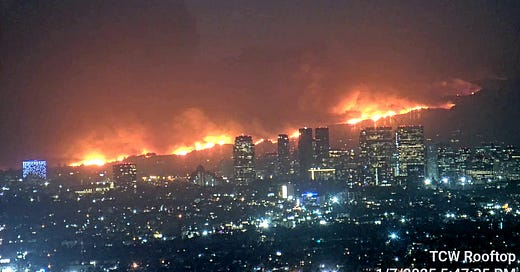A photo still image from PTZ Camera on roof of a high rise in Downtown Los Angeles - taken of Palisades Fire at peak intensity. (Source: Toastt21 [CC BY-SA 4.0], via Wikimedia Commons)
The sense of alienation runs deep through my consciousness, reverbing back and forth from fleeting thoughts, anxiety-related dreams, and orthogonal tangents on completely unrelated topics or issues, and comes forward (like a roaring train) to my attention more and more.
It is 6:15 AM, a Wednesday, January 22nd, 2025, and (AND is the phrase that should now be used in our conversational interaction with others) to replace but & however, as these two interlocutory dialogue devices (or use a technical term from my graduate ethnomethodological training - linguistic turns) may be a challenge to the listener’s narrative. Challenging a personal narrative is now verboten in the new politically correct world of the Left (and if you don’t know what the word Left means/denotes in common parlance and if you want a good example of how the internet/artificial intelligence (AI) capabilities can be employed for good, go to the footnote that contains both my comments as well as the AI-generated summary1 on what the Left is, was, and has become in American discourse below2.
It is now 8:41 AM the next day, and the shit has literally and figuratively hit the fan. I now record in the daily journal as lost days, to any day where I hang on to the roaring train (or roller coaster of nauseous up and downs) that our life or my life has become for dear life and deal hour by hour with attempting to make decisions on an hourly basis as to what should be done, what needs to be done, and I can try to accomplish as what has become my activities of daily life3 in the daily requirements for getting along.
The next morning has arrived (January 24) is a Friday, and while I have successfully managed to shift my support staff to mostly mornings, Wednesdays are completely uncovered, and Friday mornings are uncovered. I have just finished my morning orders to Amazon Prime - ‘subscribe & save’ for medications and other sundries, and now I am planning to write the updates to medication changes and send them to all the treating physicians through each of their individual, unlinked, and unmutual (note a synonym for the word unmutual is sociopath - oh the irony of our lives in the digital age) communicative EMR patient portals so that they first know what the current medication treatment regimens from the PCP, GI, Oncology, and Palliative care who are unable to coordinate their care for the one patient.
So I am going to post this, with the following conclusion and teaser for the next installment in Joel’s continuing saga and venting at the unreasonableness of the medical-industrial-capitalist enterprise (leading to poor quality of medical care, medical mistakes, and most of all, patient and caregiver distress.
Conclusion for Today -
Unintended and hidden costs (to use an economic phrase) of our human experiment with new medical and communication tools are causing the boundaries that preserve what is best about being a human being to be demolished at a rate that human culture and adaptability to change cannot sustain in the short term. Our society is falling apart like an old body that can no longer deal with physical challenges.
Hence, the metaphor that the horizon is burning and is coming for us.
Love to you all, and yes there is also hope on the horizon too, more on that tomorrow.
Cheers
Joel
Looking East for the Horizon, in the winter of our discontent ~ joelkallich.art ~ 2025
AI-Generated - JDK edited: AI can describe some striking scenes captured in photos from the recent 2025 California wildfires. The images from the Los Angeles area wildfires show devastating destruction, with entire neighborhoods reduced to ash and rubble. Many photos depict rows of homes engulfed in flames, with thick smoke billowing into the sky. Some striking images show lone structures still standing amidst a sea of destruction, highlighting the sometimes random nature of wildfire damage. Aerial photos reveal the scale of the devastation, with vast swaths of burned areas visible across the landscape. Images of the Pacific Palisades area show multimillion-dollar homes along the coastline consumed by flames. Photos also capture firefighters battling the massive blazes, often dwarfed by towering walls of fire. Evacuees are shown fleeing with whatever possessions they can gather, looking back at their burning neighborhoods. The images are a stark reminder of the unprecedented scale and intensity of these January wildfires in Southern California. They highlight the human toll and the immense challenges firefighters and communities face after this disaster.
Answer (and curated & edited by JDK)) via Perplexity AI with citations included:
In current American political discourse, the term "left" generally refers to a progressive or liberal political orientation, but its meaning can vary depending on context and usage. https://study.com/learn/lesson/left-wing-vs-right-wing-overview-ideologies-differences.html; https://today.yougov.com/politics/articles/51283-liberal-left-conservative-and-right-americans-identify-their-ideology;
Support for social and economic equality
Advocacy for government programs that aid working-class, middle-class, and low-income individuals
Promotion of civil rights for marginalized groups, including LGBTQ+ rights, women's rights, and racial justice 1 2
Favoring increased government regulation of businesses, particularly regarding environmental and workers' rights issues 1
Support for higher taxation to fund social programs and wealth redistribution 1
However, it's important to note that the term "left" is not always synonymous with "liberal" in American politics. 4 10
While liberals are generally considered part of the left, there are distinctions:
Liberals tend to support gradual change within existing systems, while those further left may advocate for more radical transformations. 1 10
The far left may include socialists and others who are critical of capitalism, which is not necessarily true for all liberals. 8 10
Recent polling indicates that about 27% of U.S. adult citizens identify their politics as "far left," "left," or "center-left" 4
However, the meaning and usage of "left" in American discourse can be fluid and sometimes contentious, reflecting the complexity of the political landscape beyond a simple left-right spectrum. 5 7
The term "right" in American political discourse generally refers to conservative political ideologies and positions. The right-wing of the political spectrum is associated with several key characteristics:
Support for traditional social values and institutions 5
Advocacy for free-market capitalism and limited government intervention in the economy 5
Emphasis on individual responsibility and personal liberty 5
Promotion of nationalism and strong national defense 5
Skepticism towards rapid social change and progressive policies 5
The right wing in American politics encompasses a range of ideologies, from moderate conservatives to far-right extremists. Some key aspects of right-wing politics include:
Economic Policies
Lower taxes and reduced government spending
Deregulation of businesses and industries
Support for free-market principles
Social Issues
Opposition to expansion of LGBTQ+ rights and certain civil rights laws 1
Support for traditional family values and religious institutions
Skepticism towards environmental regulations and climate change initiatives 1
Government Role
Advocacy for states' rights and limited federal power 1
Support for a strong military and law enforcement
Emphasis on preserving existing political and social institutions 5
It's important to note that the term "right" can refer to various degrees of conservative ideology, from moderate right to far-right extremism. The far-right, which represents a more extreme position, is often associated with white nationalism, conspiracy theories, and sometimes violent ideologies 2 4
.Recent studies have shown that right-wing extremist groups in the United States are more likely to engage in violent acts compared to left-wing extremist groups 8
. However, it's crucial to distinguish between mainstream conservative politics and extremist ideologies when discussing the political right.
Activities of Daily Living (ADL) scales are assessment tools used to evaluate an individual's ability to perform basic self-care tasks independently. These scales are crucial for healthcare professionals to assess functional status, plan care, and determine the level of assistance needed for patients, particularly older adults or those with disabilities.
Common ADL Scales
Katz Index of Independence in Activities of Daily Living
The Katz Index is one of the most widely used ADL scales - https://hign.org/consultgeri/try-this-series/katz-index-independence-activities-daily-living-adl
It assesses six basic ADL functions:
Bathing
Dressing
Toileting
Transferring
Continence
Feeding
Scoring ranges from 0 to 6, with 6 indicating full function, 4 moderate impairment, and 2 or less severe functional impairment
Barthel Index of Activities of Daily Living
The Barthel Index measures ten specific ADLs 4
Bathing
Bladder control
Bowel control
Dressing
Feeding
Grooming
Mobility on a level surface
Stair climbing
Toilet use
Transfers from bed to chair and back
Individuals are scored from 0-15 for each activity, with higher scores indicating greater independence
Lawton Instrumental Activities of Daily Living Scale
While not strictly an ADL scale, the Lawton IADL Scale is often used in conjunction with ADL scales to assess more complex activities 3
. It evaluates eight domains:
Financial management
Food preparation
Housekeeping
Laundry
Medication responsibility
Shopping
Telephone use
Transportation management
Scores range from 0 (low function, dependent) to 8 (high function, independent) 3
Importance and Applications
ADL scales are essential for:
Assessing functional status in older adults or individuals with disabilities 1
Predicting admission to nursing homes, need for alternative living arrangements, and use of paid home care 6.
Evaluating treatment outcomes and changes in health status over time 6
Planning appropriate care and support services 6
Determining eligibility for state and federal assistance programs 4
Healthcare providers, particularly nurses, routinely use these scales to screen patients and identify declines in functionality during hospitalization 6
Limitations
While ADL scales are valuable tools, they have some limitations:
They may not capture small increments of change in rehabilitation settings 8
Self-reported scales may lead to over- or underestimation of abilities 4
Some scales, like the Katz Index, focus only on basic ADLs and do not assess more complex activities 5
In conclusion, ADL scales are crucial instruments in healthcare for assessing functional independence and planning appropriate care. While they have limitations, their widespread use and validation make them indispensable tools in geriatric care and rehabilitation settings.





